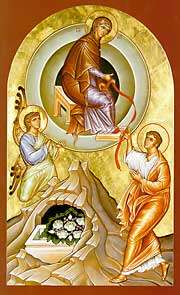Holy Girdle
The Holy Girdle, also known as the Girdle of Thomas, Holy Girdle of Mary, Holy Soonoro, (or) Zunoro, and Holy Belt of Saint Mary the mother of Jesus, is a relic of the Blessed Virgin Mary which is one of the important relics of Syriac Orthodox Church and venerated by Oriental Orthodox Communion. The word "soonoro" is also translated as "belt", "sash" or "girdle". It is the Oriental Orthodox equivalent of the Girdle of Thomas in the Western church, and the Cincture of the Theotokos in the Eastern Orthodox Church, now located at Mount Athos.
| Holy Girdle | |
|---|---|
 Holy Belt of Mary | |
| Material | Knotted Textile Cord |
| Size | Length (74cm) Breadth (5cm) Thickness (3cm) |
| Discovered | 1852, rediscovered April 1953 Saint Mary Church of the Holy Belt, Homs, Syria |
| Discovered by | Patriarch Ignatius Aphrem I Barsoum |
| Present location | Churches in Syria, India, Middle East |

Tradition
According to Orthodox tradition, the Virgin Mary died in the presence of all apostles except Thomas, who was in India. He returned to Jerusalem and travelled on the sky by the help of Holy Spirit to attend the assumption of Mary. He was late to arrive and visualised that Mary's body had been taken by angels. Suffering from doubts at that time, Thomas requested Mary to give him a sign in her memory, which caused a chariot to stop in the air and Mary to gift her girdle to him. Thomas showed this girdle to other disciples of Jesus and convinced them. He took the girdle, otherwise known as a zounoro, on his subsequent journeys. Those who believe in him claim that many miracles have happened since then as a result of touching or even seeing this girdle. The incident is not recorded in the bible.
The Holy Girdle is taken out annually on the last day of 8 Day Lent in September.
History

Saint Thomas the Apostle kept the holy belt with his own. After he died in Mylapore, his body and relics were kept in India. In 394 AD, the holy girdle moved from India to Uraha. and then to Homs in Syria, where it was placed in Saint Mary Church of the Holy Belt, also known as The Church of the Lady of the Girdle. The supreme head, Ignatius Aphrem I Barsoum, Patriarch of Antioch, studied manuscripts and a Garshunian book containing stories and speeches send by the people of Homs in 1852. The archbishop of Homs ordered to renovate the church. On 20 July 1953, the Holy Girdle was discovered from the altar of the church by Barsoum in the presence of Alexandros, the Greek Orthodox bishop of Homs and it is scientifically proved.[1] It is considered to be one of the most important relics in Syriac Orthodox Church.[2]
Malankara Church
The Some parts of Holy Girdle is distributed into the Malankara Church. The churches which the relic is installed are known as Soonoro Church.[3][4] These include:
- Kottayam Cheriapally Mahaedavaka (St Mary's Orthodox Church, Kottayam, Kerala, India) belonging to the Kottayam Central Diocese of Malankara Orthodox Church is the first Church in India to have Holy Girdle of Saint Mary. Holy Girdle of St. Mary was placed in Kottayam Cheriapally on January 16, 1966 (Sunday) by Baselios Augen I, the then Catholicos of the East & Malankara Metropolitan. Holy Girdle is kept for public viewing in the church every year from August 10 to August 15.
- Manarcad Church – Malankara Jacobite Syriac Orthodox Church, Universal Marian Pilgrim Centrer
- Mor Ignathious Noorono Syrian Simhasana Church, mekkadampu
- Jacobite Syrian Cathedral Kundara – Kollam Diocese of Malankara Jacobite Syriac Orthodox Church
- Kothamangalam Valiya pally Malankara Jacobite Syriac Orthodox Church the Angamaly Jacobite Orthodox Diocese[5]
- Mor Gregorios Jacobite Syrian Orthodox Cathedral Mettuguda (Secunderabad)[4]
- St Mary's Jacobite Syrian Valiyapally
- St. Mary's Church Meenangadi – E.A.E Archdiocese of Syriac Orthodox Church
References
- http://www.syriacchristianity.info/doc/HolyVirginMary.htm
- The Oxford History of Christian Worship | pg 157 | https://books.google.com/books?isbn=0195138864
- http://kundarajsc.com/about_soonoro.php
- "The revered relic - Tirupati". The Hindu. Retrieved 2018-01-29.
- "Martha Mariam Cathedral Valiya Pally Kothamangalam(St.Mary's Church)". Valiyapally.com. 2014-08-15. Retrieved 2018-01-29.
